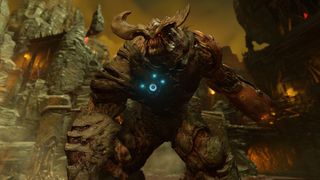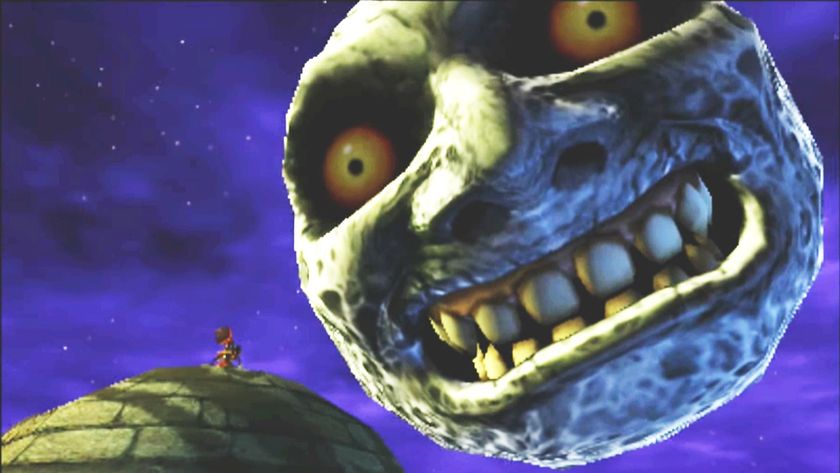Doom's most exciting, progressive moment is a quiet one with no shooting
Even semi-regular readers should not be surprised by my pointing out that I’m excited about Id Software’s new Doom sequel-cum-reboot. The game’s intelligent ferocity, its fast, flowing combat, and its deliciously vile, nonsensically gory sense of humour already have it flagged up as one of my most anticipated games of 2016. And in terms of FPS, nothing else comes close. Basically, this is me right now, all day, every day.

But please don’t think that I’m coming at Doom with the simplistic perspective of a nostalgic bloodluster, all red-knuckled air-punches at the thought of some more ‘old-school’ action – that most nebulous and time-twisted of notions. Beyond the obvious, incendiary spectacle of the new Doom’s triumphant, sensory assault, I’m really excited about the intellect that already looks to be at play under the roadkill-encrusted hood. I'm excited about the pace and flow of the combat model, and the sheen number of strategic options on offer. I'm excited about how the new SnapMap editing suite offers the central, creative joy of modding without the need for mods. I'm excited about the developments in immersive, first-person storytelli-
Hang on a minute. We’re still talking about Doom here, right?
Yes we are. Stay with me on this one. Because FPS, despite its ostensible focus on murdering the living crap out of hordes of clone-stamped enemies in (hopefully) a variety of strategically creative ways, has actually thrown up some of gaming’s most interesting storytelling evolutions over the years. Okay, so when I say ‘FPS’ here, I’m primarily talking about ‘FPS made by Valve’, but the point is that games like Half-Life, Half-Life 2, and Portal weren’t happy to simply play with the action-based immersion afforded by the first-person perspective. They fully embraced the world-building and wider experiential opportunities too, and yielded fantastic, medium changing results.

Now Doom was always going to be a trickier proposition. Because while Valve’s universe, shared by the aforementioned series, has decades of rich lore, varied species, and eclectic environments to play with, Doom, at its best, has always been a far more direct experience. One marine, a lot of guns, even more demons, and a whole lot of relentless killing.
The killing part, I never had any doubt about. But story? Yikes. That had me worried. Because however true to the spirit of 1993 Id’s latest tries to be - however well it recaptures that gratifying, moment-to-moment gunplay, that dynamism and energy, that sheer sense of endless, in-the-moment momentum - the fact is that it needs a narrative. Modern gamers demand one. Over the course of a presumably lengthy FPS campaign, story just has to be there. But how to balance it? Doom 3’s Doomguy might have remained the strong, stoic silent type, but his journey to Hell and back was staggered and stalled by multitudinous, pace-killing cutscenes, audio diaries, and text logs. Oh god, those text logs. There was not a great deal of momentum. Not for any extended period of time.

That – obviously now, given the seeming conceits of the current game – was unlikely to be the right direction for the new Doom. But that didn’t mean that it wouldn’t happen if Id couldn’t think of a better idea. But now that I’ve seen (and re-seen, and seen again) Doom’s lengthy E3 2015 demo, I am almost devoid of worry. Because there’s one scene, a quiet, innocuous, rarely discussed scene, that has me as excited as anything else in that gameplay footage.
Sign up to the 12DOVE Newsletter
Weekly digests, tales from the communities you love, and more
There’s a point, seven minutes and eight seconds in, when Doomguy comes across a locked door. It’s opened by a handprint scanner, but Doomguy’s hand isn’t up to the job. He fires up a floating, hologram-projecting drone, which proceeds to play back a 3D recording of events in the room before his arrival. A static-blurred, white hologram, depicting a Baron of Hell, flickers into disturbing life, dragging the digital ghost of a previous human victim behind it. For a moment, it appears to look straight at Doomguy, a glare of unknowing threat passing between the two across who knows how many hours or days. Then it stalks away down the corridor and around a corner, before flickering out. This all takes seconds.
In those seconds we’ve learned many things. We’ve learned that this office was attended by a specific security guard. We’ve learned why he is no longer here, how he met his end, and by whose – ahem - hand. We’ve got to know a character by vicariously reliving his final moments, and he’s passed on both Doomguy’s next objective, and a clue as to how to complete it, without direct address or even words.
Just as importantly, we’ve had a foreshadowing glimpse of the Baron’s power and persona. The ambient storytelling is reaching into Doomguy’s future, as well as the unfortunate guard’s past. The above feats, achieved in Doom 3, would have required four hacked computer consoles, three audio diaries, a full, back-and-forth e-mail thread, and about half an hour. But here, seconds. It’s remarkably economical design. In both philosophy, execution, and impact, it has serious echoes of From Software’s excellent, incisive work in Dark Souls and Bloodborne.
A quick jaunt after the spectre, and Doomguy finds the very dead guard. He tears the guy’s arm off (hey, Doomy needs it more right now), takes it over to the scanner, and opens the door with the security-approved handprint. And that’s it. The entire sequence lasts little over a minute, and then the breakneck killing recommences.

If Doom is going to have a story – and it is, of sorts, at least – then good Lord, is that ever the way to deliver it. Fast, visceral, and entirely, coherently grounded within the immediate fabric of Doomguy’s journey - but never encroaching upon or distracting from it - the hologram method enriches his story with the background detail of others without ever invading, slowing, or taking the focus away from Doom’s classically in-the-moment philosophy. It allows a whole cast of characters to appear and disappear at will, a less invasive spin on Half-Life 2’s real-time ‘cutscenes’ entirely feasible, but without the additional baggage of having the world, story, or Doomguy’s path be prescriptively shaped by them.
Adding story to Doom without diluting the Doomness of it all was always going to be tough. That’s why, I’d hazard a guess, Doom 3 went in a radically different direction. Id’s 2004 entry smacks of a game at a crossroads on the path of gaming’s progress. Unsure of how to marry Doom’s old values with the trappings of the contemporary shooter, it took the safe option and went full-tilt in the direction of the modern, leaving its troublesome past behind. Along the way, it made a good, visually stunning, chokingly-tense horror FPS, but it didn’t make a Doom game. But with a decade to consider things, the new Doom seems to have finally cracked the conundrum.
You can add story, and narrative texture, and depth of world to a game that doesn’t have time to stop and listen. You can add narrative without adding narrative breaks. You can provide meaty modern content while still having it feel like a garnish to those only interested in the main event. You can have a Doom that now feels like the total, modern package, but without losing any part of its old self. So I’m excited about the new Doom. I always was, of course, but now I’m excited in a way that, much like Doom itself, feels entirely complete.
Most Popular







